May 2011
L’Azalai and Other Tales
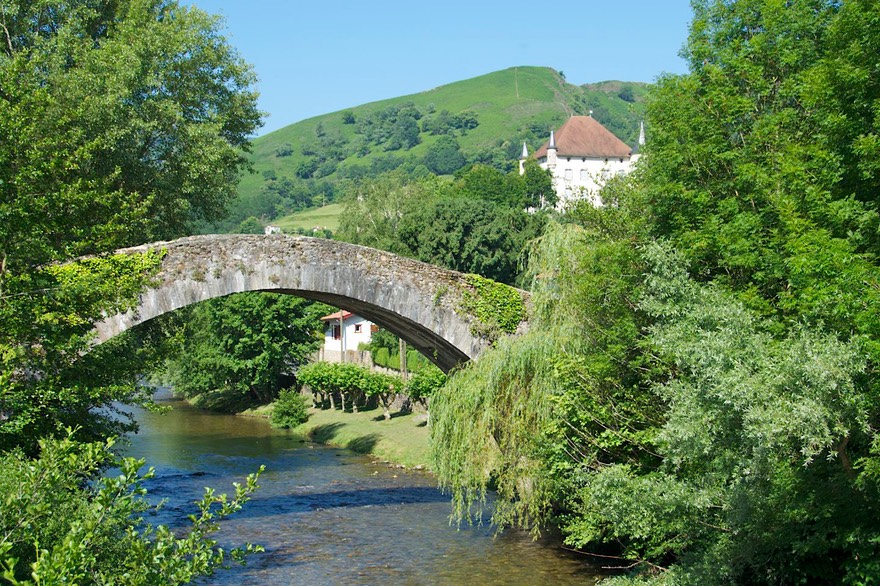
We’ve seen the Pyrénées from all sides now… and they really have been terrific whichever way we’ve approached them. Beautiful high peaks, lovely forests, wonderful farmland in the foothills and villages to die for. But first, I must tell you that we’ve finally run out of storks. So far as we can tell, France doesn’t have any. We seem to have left them behind in Spain after enjoying them everywhere in Spain, Portugal and Morocco. Quite a surprise... where do French babies come from???
We’d really had a good time in the Spanish Basque country, culminating in a great wander through the Spanish side of the mountains. Crossing into France, we were hit with the culture shock we’d been expecting ever since we left Morocco. Quelle difference! So many more folks; cuter towns and so much more tourism; tons of motorhomes. Trying to figure out why, we took a good look around, and realized we were in a very popular area for people who like fancy food and wine, Basque goodies like clothing, food, etc. We were in a Tourist Destination – EEK! Cute little red berets were on every second grey head spryly hopping off a tour bus. We stopped for the night in Espelette, and there were more tour buses than parking spots; we already missed the lovely and quiet Spanish side of the mountains.
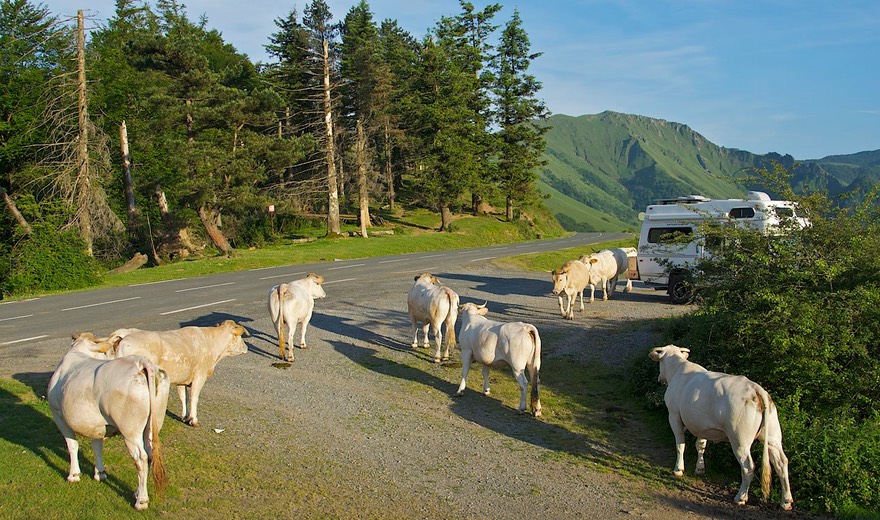
But, hey, it was a pretty area and the weather was terrific. Folks were out enjoying springtime. We were too, but decided we’d like it quieter, so we a few quieter towns to wonder through,then sashayed on along a narrow mountain road and spent the next night looking at a great view of the mountains, parked among a herd of lovely fawn-colored cows, with nary a tour group in site; definitely more our speed.
We spent the next several days wandering the mountains, communing with the critters, and dodging the occasional logging truck working the forests. Dry hillsides alternated with wet ones covered with ferns under the tree canopy. Lots of cattle and horses; we started coming up on signs saying something about “Barrières Canadiennes”; at first we thought the locals had something against our North American neighbors, but then we decided “canadienne” probably had something to do with the livestock, because the signs were all next to cattle guards. Certainly hope I’m right! (Our tiny little pocket dictionary was useless on this subject. Natch.)
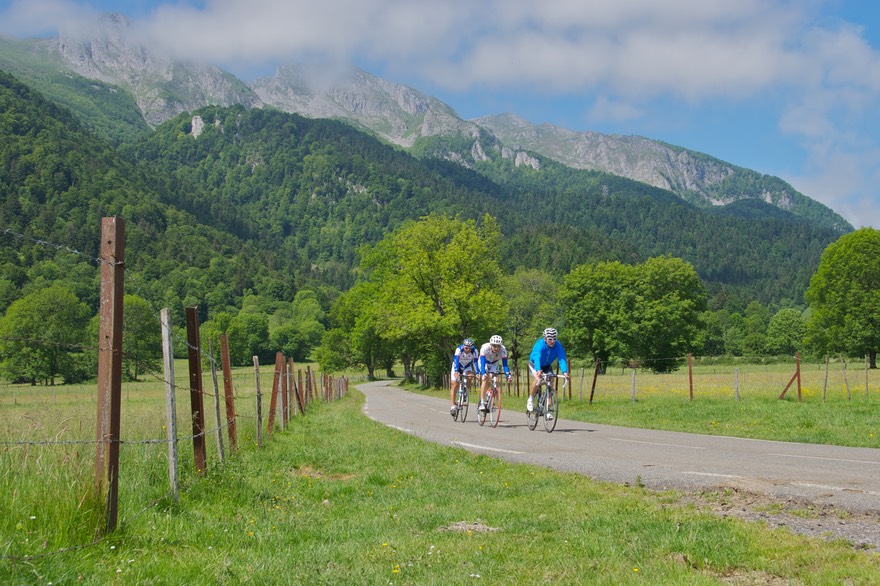
Other than livestock, what we mostly saw were – cyclists. This area is terrific for biking (and motorbiking as well). The weekends particularly were full of them, including a race we saw the beginning of, since it started in the town where we had spent the night (Soulum). It’s quite apparent to us that everyone in France cycles; it’s a national pastime. The roads are absolutely jammed. We also soon realized that we were wandering in Tour de France country. We saw lots of signs saying when the big race would be coming through, and marking the date of the year a particular town first had that honor. It’s very exciting; we drove up over several of the passes that are part of the tour route; WOW, are they long and tough and high! At the top of the Col D’Aubusque, there were super-large bicycles set against the hillside, with people walking around underneath them; they immediately conveyed some of the emotional impact of the spot. It was also in this area that we saw writing on the roadbed, with the names of some of the more famous participants and words of encouragement. We felt privileged to have been here.
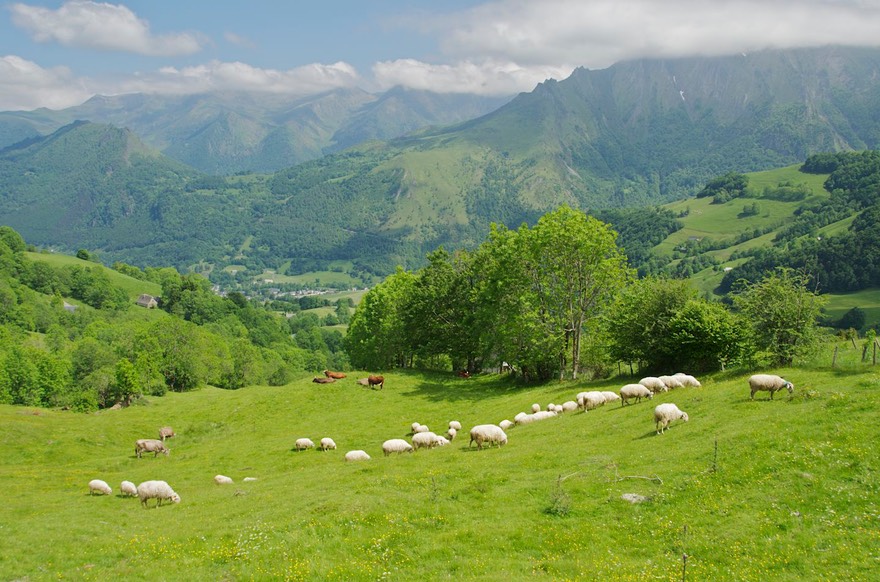
Along with the high passes, mountains in Europe come equipped with tunnels, and we’ve seen our share. Some of the tunnels, particularly in the high Alps, are very long and come with toll booths. We’ve been able to stick to little tunnels so far that are free. These have been short (mostly) and often older and quite tiny: so far we’ve not had to turn back, but keep our fingers crossed for the future.
And speaking of passes, we’ve been over a zillion. Tiger takes them in stride, and the views from the top are always awesome. In the area between Eaux-Bonnes and Argèles, going over the Cols (passes) d’Aubisque and du Soulour Gazost we saw some pretty amazing scenery; it was high and barren and we commented on how it reminded us of our time in Peru.
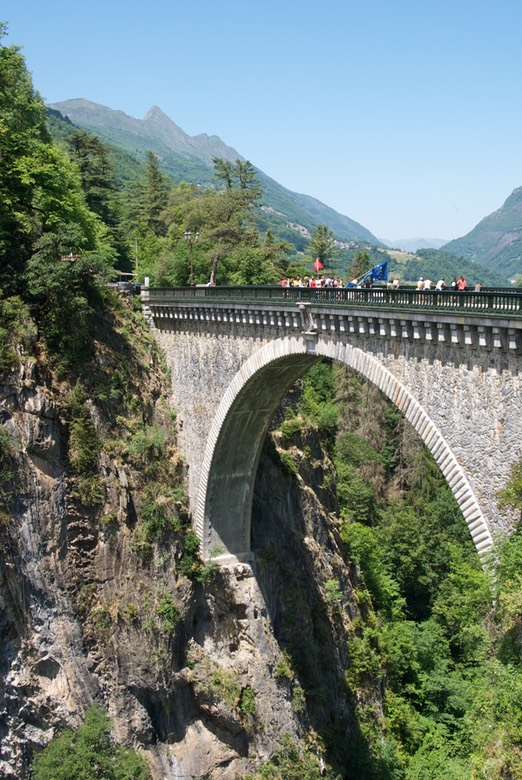
After going over the Col de Tournalet we started to head for lower elevations. It was time to begin moving toward Provence, enjoying the Languedoc area on the way. But before we even got all the way down the pass we’d spotted a new sight for us: bungee jumping off one of the bridges over the beautiful gorge we were following down out of the mountains. It reminded us how close we were to the rest of the world, even though we’d found so many out-of-the-way, pristine spots where we were totally isolated. The bungee-jumping was bit of a jolt – visually for us, but literally for the guy at the end of the bouncing cord. We found ourselves trying to picture the scene hundreds of years ago when these bridges were being built, “Wow, what a great spot this will be for bungee jumping someday.”
Well, have to tell you we think the Pyrénées are the best place we’ve been in Europe – so far. We just love it here, and hope to come back again some time, especially with motorcycle in tow. We’d seen the eastern end in fall color last year and now the western end in fresh spring growth, in both Spain and France; as good as it gets. We felt like we could have wandered in the mountains for months yet, but we really do have a plan for this year and it includes covering a lot of ground through northern Italy and the Balkans, then Turkey and Greece. So at some point we had to cut and run. Who makes all these plans anyway?
Working eastward, but out of the mountains, we wanted to visit some of the quiet country west of Provence that doesn’t get much mention in the guidebooks. This is the Languedoc region and boy did we ever enjoy it. We poked around little towns and traveled small roads lined with trees planted by Napoleon. We stayed two days beside a lake on the edge of Lisle-sur-Tarn, a medieval village with buildings on the square that dated from 1300. We saw amazingly beautiful farmland rolling over low hills, bordered by rushing streams and large rivers. Looking back, we really wish we’d spent more time in this region than we did.
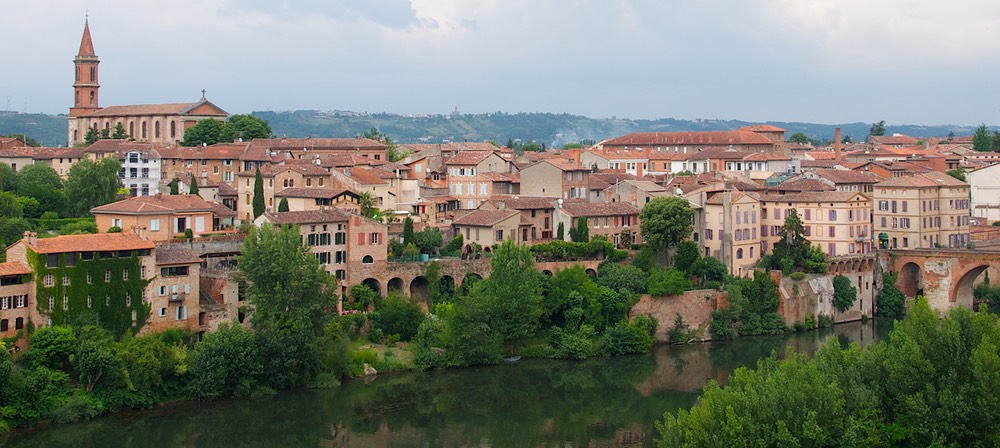
We spent a night parked below the awesome cathedral at Albi (largest brick cathedral you can find anywhere – if you care). Now this was a cool cathedral; stunningly painted interior, great statuary, all the good stuff. Albi was home town to Toulouse-Lautrec, by the way; the museum devoted to him has an extraordinary collection of his works, including large original posters and lithographs that were very exciting to be able to see close up. It was hard to leave.
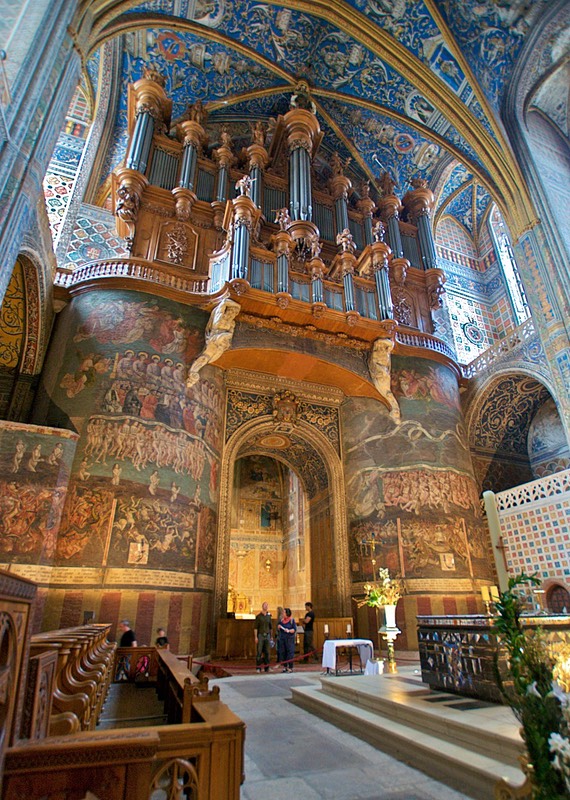
Albi sits on the River Tarn, a lovely site all by itself. There are several ancient bridges that cross it, giving you views of the city from across the way. A second museum we really enjoyed was, fittingly, on the other side of the river. It was devoted to the sea explorer Jean-Francois de Galaup, Count of Lapérouse, who commanded an around the world voyage of scientific exploration that left Brest in 1785. He did not return home, both of his ships being sunk by a storm in the Solomon Islands three years later. Along the way, however, he was able to send home a great deal of valuable information, so much is known of the voyage. We spent a lot of time here, reading all about his exploits and adventures. As with so many museums in France, the materials were well mounted and explained, and there were many artifacts and maps to be enjoyed as well. It was a great experience and afterwards we could gaze back across the river at the Cathedral and old town.
A little further east, in the Haût Languedoc region, the cherries were ripe in the orchards that spread over the low hills, and cherries and cherry products were everywhere, along with many chances to buy them; a good sign that summer is almost upon us. We took a bit of a break from sightseeing to hook up with our American friends Evelyn and Steve Fincham; they shipped their motorhome to Europe about two months ago, intending an extended wander. It was great to see them, and we laughed and giggled at our experiences, talking a mile a minute and knowing that they would understand every word we said. Lots of fun. We left them headed for the Pont du Gard and points west, while we headed down to the Marseilles area for a couple of days.
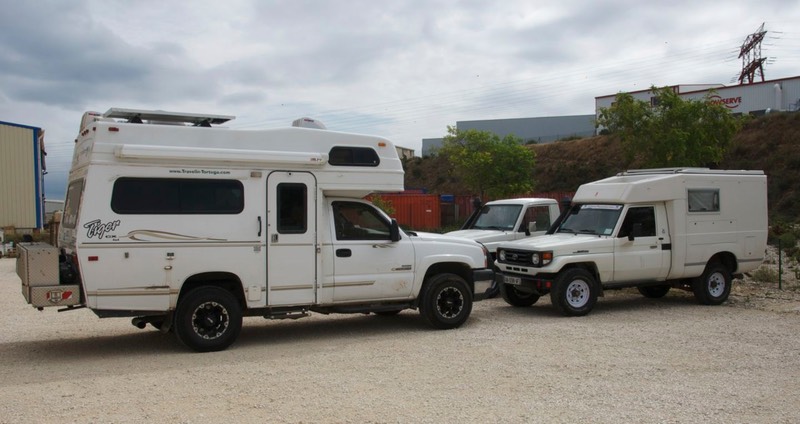
Marseilles? Why? Well, naturally, to see a guy about – a French rig used for overland travel. No, we aren’t trading in La Tortuga – not a chance of that – but we’d run across one of these cute little things in Morocco and since the factory was nearby, sort of, well, you know how it goes. The vehicle is called L'Azalai, which is a Toureg (a north African nomadic tribe) word meaning a camel caravan. They are built on Land Rover or Toyota Land Cruiser chassis and are intended for four-wheel drive expeditions in the desert or other difficult areas. While they are very small, only about 16' long and with a pop up top, some owners have taken them on multi-year trips around the world. They are simple and basic, but very light, very well built, and can be shipped in a container. A really fun part of our visit was that everyone there was fascinated by our Tiger. When we first arrived, all of the factory guys dropped everything to come out into the parking lot and see it. Later on, after we finished the tour, Bernard, the owner and designer of L’Azalai and his wife, Lucille, came out to look as well and they were both quite impressed. In talking about our travels and what we wanted our vehicle to do, we all agreed that the Tiger was much more suitable for us than the L'Azalai, neat as it is. (La Tortuga sat through it all looking very complacent, if perhaps just a bit pudgy.)
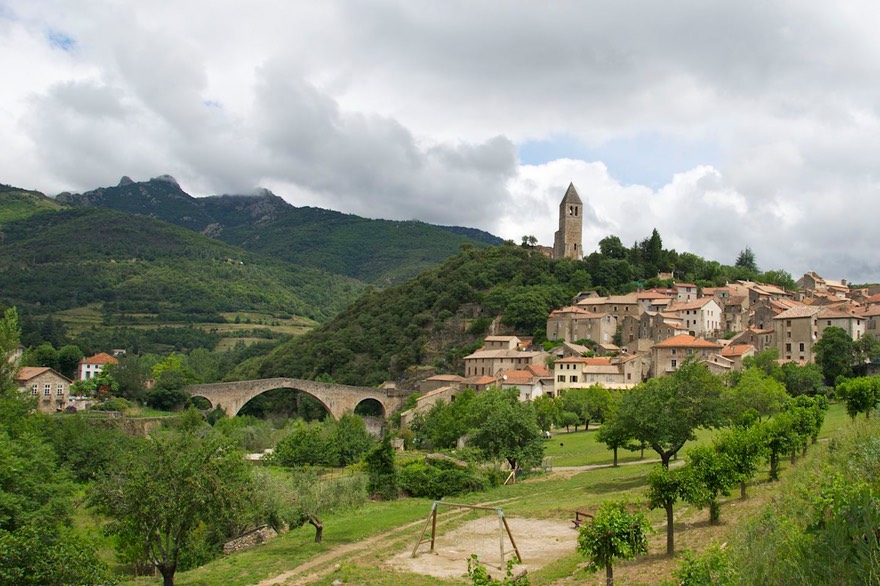
After spending the night in their parking lot, we said goodbye to Bernard and Lucille and continued on our way. We had decided it was time we saw a Roman ruin… in France. Now, of course we’ve been seeing them all along; our best memories are from our visits to Volubilis in Morocco where the site is out in the middle of nowhere with miles of nothing all around it; and of both Wroxeter Roman City and Hadrian’s Wall, terrific sites in rural England with great explanatory information both out on the site and in lovely museums next door.
We were now in Provence so we had our choice of several sites; we could go to Arles or Avignon or perhaps Nîmes. But, looking for someplace a bit quieter, we decided to pick something we thought might be perhaps a bit off the beaten track. We settled on Orange, home to the best preserved Roman theater in all of Europe, so they say, along with a cool Arch, and who’d ever heard of Orange? So off we went. And it was, indeed, less impacted. We were able to park close to the theater, and to get a good view of the open interior from atop a nearby hillside (this walk had been recommended in the guidebook, which said this was the best overall view). Our ability to appreciate the historic aspects of the ruin were not helped by the theater being in the middle of downtown Orange, with traffic everywhere, street markets jamming up all the available space, and Andean pipe music being amped from across the way. And, unhappily, inside the theater modern tiers of metal seats had been set up in place of ancient stone, and technicians were clambering all over setting up for a concert.
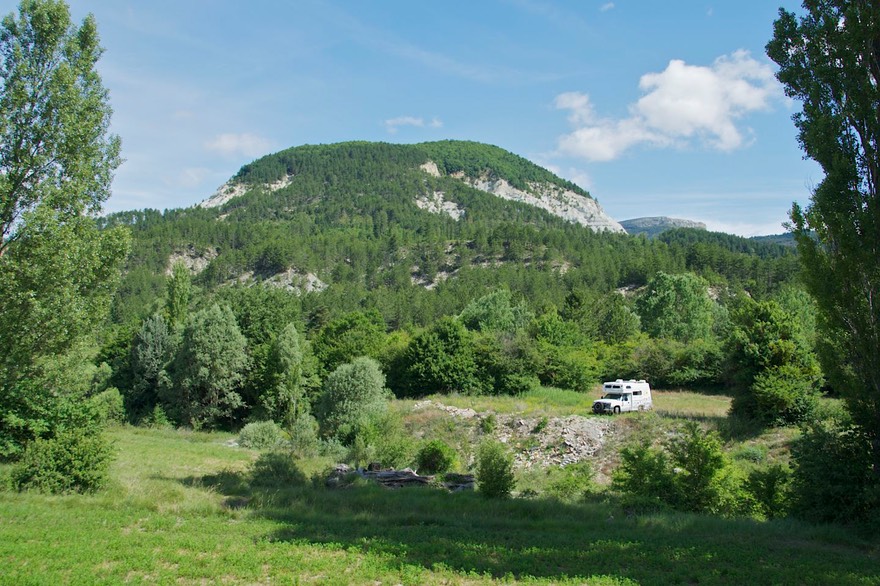
This kind of scene is a tough sell for us. We greatly appreciate historic buildings, but they are hard to enjoy in the middle of a madhouse. We have been so lucky to have visited sites, in various countries, where the ruins are isolated in fields, or have by other means had lots of space set aside for them. So, in a way our visit was a disappointment; but the Arch was very cool, and we saw some interesting other buildings as well.
We had trouble leaving town, incidentally, because there were several very low underpasses we couldn’t negotiate, despite Emily’s well-intended GPS instructions. But we managed eventually, and emerged out into a countryside filled with vineyards, fruit trees, and small hill towns, each with a church at the top. The weather is lovely and warm, and the grapes are tiny but quite evident. It’s a very nice area. And the lavender is in bloom. We passed fields of it, and opportunities to buy lavender honey, lavender soap, etc. All just great. We camped for 3 days beside a stream in a rural part of absolutely nowhere, in the Vallée du Jabron. This was our Provence. An area where we could get away from the hordes and the overly cutesy villages with sidewalk cafes crowding the already narrow streets, all just a bit much for us thank you.
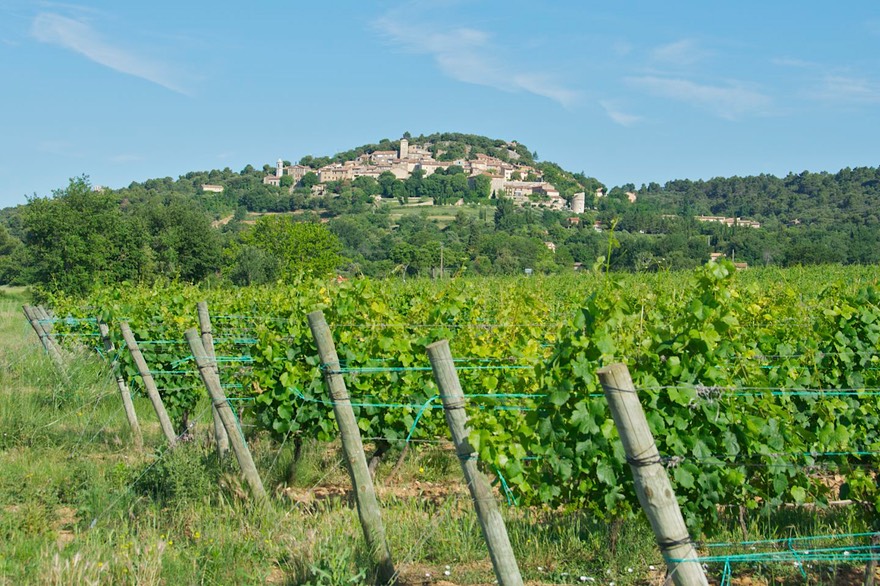
By the way, did you know that those jeans you’re wearing, made of denim, originally came from Nîmes (“from Nîmes” is “de Nîmes” in French and pronounced “de Nim”). I know, the anecdote takes longer to explain than it’s worth, but you takes your pleasures where ya finds ‘em. At any rate, the story is that this tough material was originally developed to manufacture clothing for slaves, hmmm.
We met some new traveling friends when we stopped for the night in the charming town of Mirabel-aux-Baronnies. Mike and Liz Green have been traveling since 1999 and have been to many of the same places we have, such as Latin America, but have also spent time in places we still have on our wish list such as New Zealand and Australia. They are gearing up for a trip to southern Africa, also on our list, and are out and about doing something of a shake down cruise on a great looking overland vehicle they’ve just had made for them. Once again it was a delight to sit around and chat about places been and yet to be and to laugh at our shared experiences. Right off the bat we discovered mutual acquaintances from the US, Frank and Annie Cartwright, who are planning to meet up with Mike and Liz in Africa later this year; just one more serendipitous experience in our life on the road.
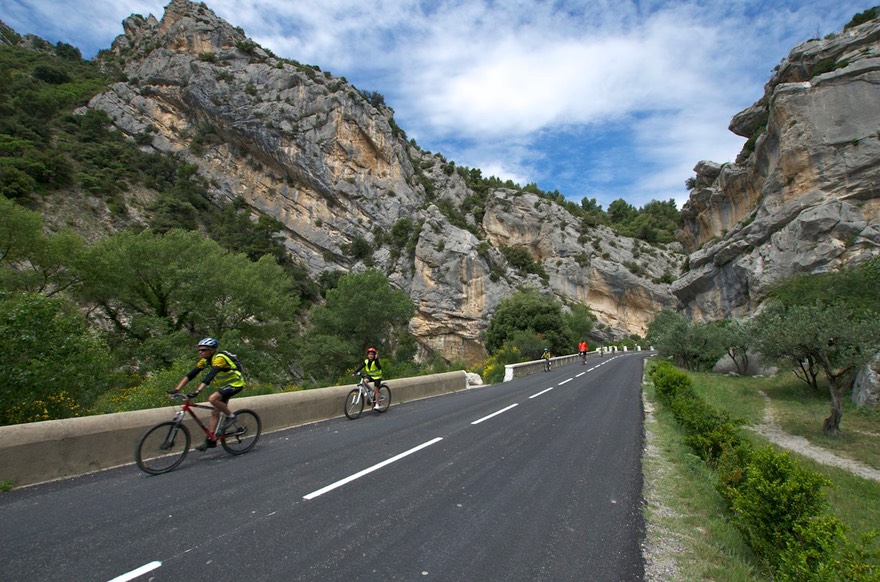
Many of the small towns were enjoying having a circus carnival come through. We saw their rigs on the road, being transported to their next gig. We found them stuffed into the central areas of villages, the games and rides taking up the little bits of space where in other times we might have been able to park. We remembered that we had seen similar folks in the small towns in Belgium and northern France last spring, so we assume that these numerous troupes are everywhere in Europe right now. They are loved and well attended; folks come in by the busloads to enjoy the action. For us, the circus makes it even harder for us to get through these tiny, ancient streets, so we usually try to loop around the action. As a consequence, we didn’t visit some promising-looking spots, such as Aups, Annot and Entrevaux. Put them on your list to check out!
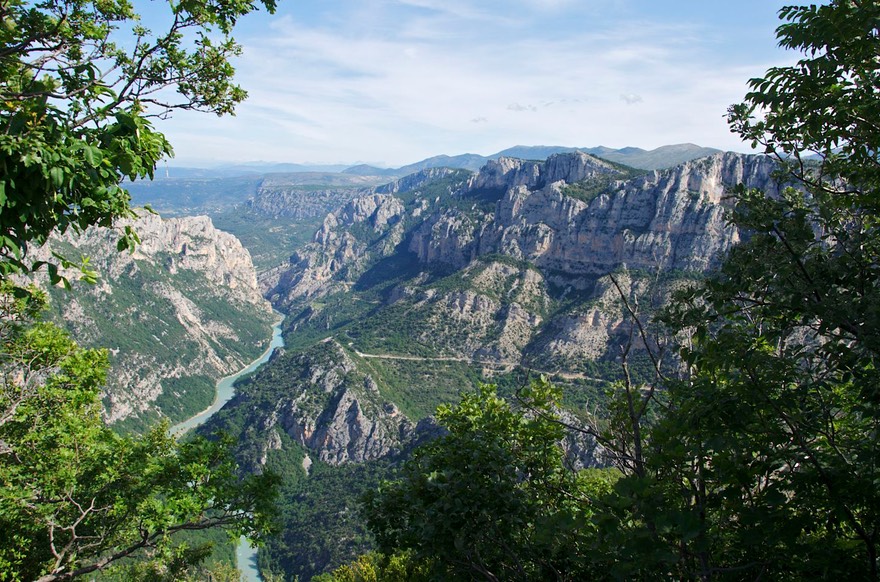
We did passes, and also we did gorges. One of the most famous, in a lovely area of rural Provence, is known as the Grand Canyon de Verdon and said to be the largest gorge in Europe. Well, maybe. But we enjoyed it, touring the south rim and chatting with folks at each and every pulloff. Several had visited the United States, and we discussed the relative beauty of each area. But even more interesting, we talked with a cyclist who was on his way into northern Spain – from his native Slovenia. We had a very nice visit, and Andrej apologized that he would not be at home when we came through in a month or so, but made several recommendations on areas to see while we were there. Very nifty.
The further east you get in southern France, the higher the hills become as you enter Les Alpes-Maritimes. We left the relatively flat terrain of western Provence and once again enjoyed lush forests, passes reached by negotiating lacet after lacet (this is the French word for “lace” and they use it for what we would call a “hairpin turn”). We found ourselves on some really tiny roads, something that normally doesn’t faze us. But these were often running through narrow gorges, with rock walls and overhangs bordering the road, and there were all these other people. Rick was heard to mutter that we’d been on smaller roads, but never on roads this narrow with this much traffic. You see, we were just inland from Nice and Monaco and the Côte d’Azur. There are no isolated areas in this neck of the woods! All those folks have homes up here. Traffic everywhere. I spent some time thinking about Grace Kelly; she must have died on just such a road.
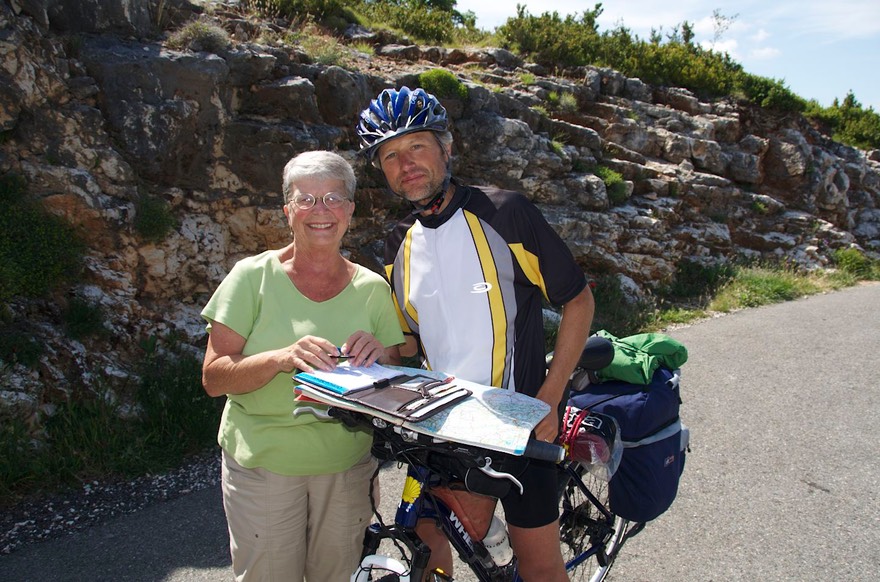
But the views are terrific and we did just fine. Well, except for Rick’s tired and sore muscles from pulling the truck around all those turns while hugging the rocks and guardrails on our side of the road. We were aiming for the pretty resort town of Sospel, basically chosen by putting a finger down on the map and saying “This looks like it would work” several weeks back. We were having our mail delivered here. Amazingly, all went well. We called in at La Poste, which was actually even open, Rick handed over his passport, and the nice gentleman fetched our parcel – new crossword puzzles books at last!!!
We wanted to see more of the Alpes-Maritimes, but were uninterested in retracing our steps over all those busy, winding roads (new ones would be fine). So we ducked across the border into Italy for a couple of hours, and went north a ways on a nice, civilized, wide-enough road to be comforting. Our first sightings in Italy made us want to hurry and come back; the houses were more brightly colored than in France, and the terrain on this side of the mountains was less severe; we loved the grass carpeting the hills above tree level. We’ll be right back.
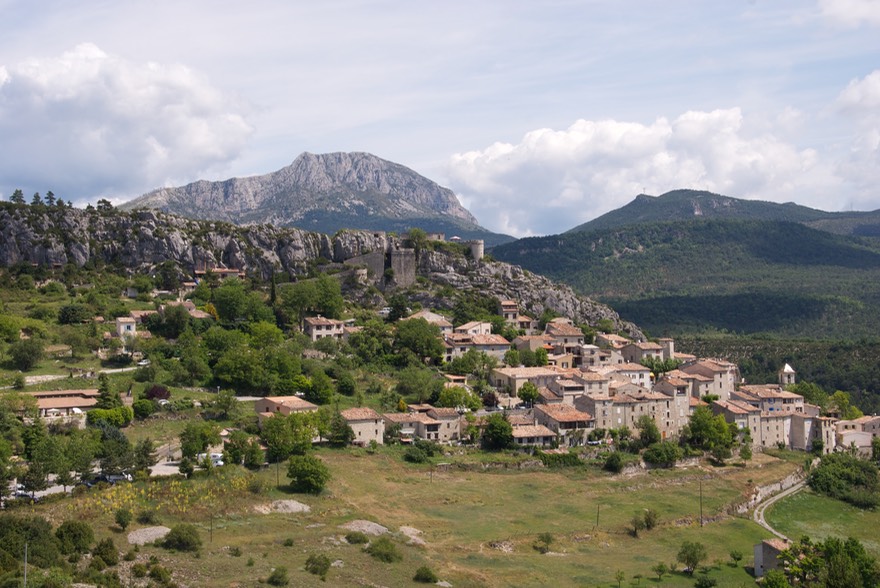
But soon enough we crossed over the Col de Maddalena and went back into France for another couple of days. We’d been told the area around Gap was pretty; from there we could go to Briançon and cross the Col de Montgenèvre back into Italy, heading for Torino, our first planned stop. The area was just as nice as advertised; unfortunately it had turned rainy, so you will have to trust us on this one. We started saying how “alpine” things seemed; well duh! Chalet-style housing, fields of low mountain wildflowers, ski resorts around most corners; what should we have expected? After all, we weren’t far from Grenoble. We spent our last night in France in a meadow across from just such a chalet, with a mountain behind it almost hidden in the rainy mists. A lovely scene.
The next morning we headed further up over the mountains, heading east. We had a couple of bad moments as we came into Briançon; there were big signs saying, in both French and Italian, something about the pass being “interdite” and “durée” and “eboulement” and perhaps worst of all, “indeterminée”, along with a bunch of other words not in our dictionary. But we decided to press on.
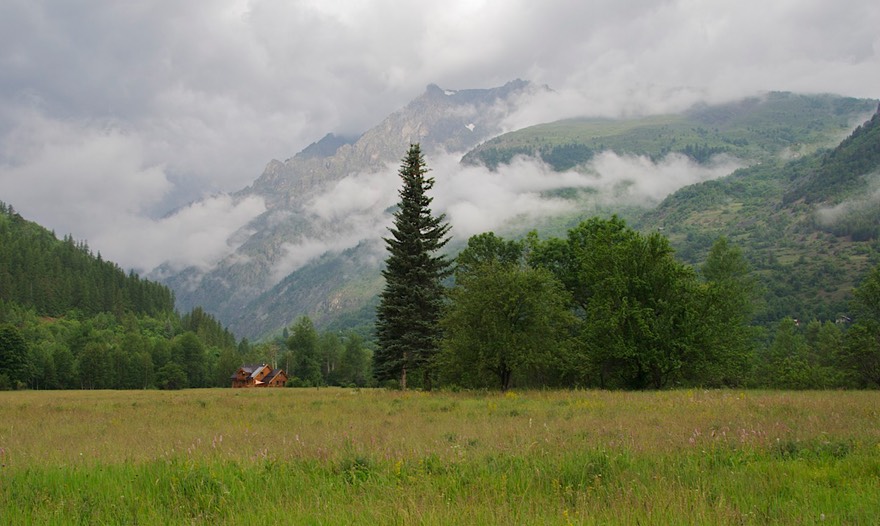
We stopped for a last opportunity for free wifi at the last French McDs available (McDs handles wifi differently in Italy), picked up a few groceries at French prices, fueled up, and took off. It was raining hard, and foggy, but we saw cars coming at us, mostly with Italian license plates, which we found encouraging. We came over the top and started down the other side easy as pie. We were never stopped, and there were no problems, but we commented that the road was surprisingly quiet. Now, whether it was just a quiet, rainy Saturday over the pass or it was only quiet because most everybody else could read the signs and knew they weren’t supposed to be there…. We’ll never know.
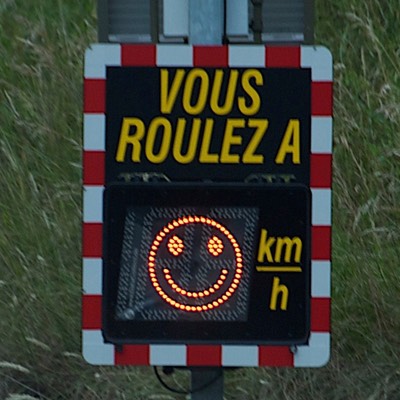
We have now finished our fourth foray into France and there will surely be more. Given its location, France is sort of on the way to many other portions of Europe and that seems to be how we will be seeing it. Who knows? As we have each time before, we enjoyed our French experience for this year, particularly our times in the mountains. And now? On to the Italian Campaign!
Have a wonderful summer; we’ll see you on the other side of Italy!
Rick and Kathy and a rather smug but much loved La Tortuga
Click to see more photos from France